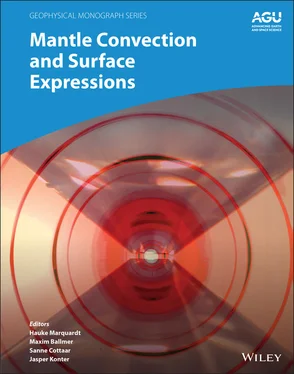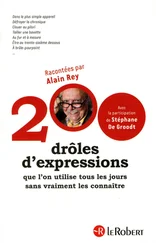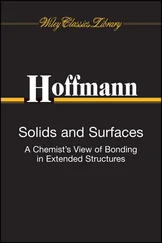If we accept steeper‐than‐PREM S‐ wave velocity gradients and lower‐than‐PREM P‐ wave velocities as signatures of peridotitic rocks in the lower mantle, we find that a complementary lithology with higher‐than‐PREM P‐ wave velocities and lower‐than‐PREM S‐ wave velocity gradients would be required to match PREM as an average between these two lithologies. Based on the here‐used mineral‐physical data set ( Table 3.1and Figure 3.7), iron‐free bridgmanite compositions, i.e., MgSiO 3and (Mg 0.96Al 0.04)(Si 0.96Al 0.04)O 3, would satisfy these criteria. Rocks that are dominated by iron-poor bridgmanite could therefore compensate for the steep S‐ wave velocity gradients and low P‐ wave velocities of former upper‐mantle rocks, such as pyrolite and harzburgite, that sink into the lower mantle as cold slabs imaged by seismic tomography (Fukao & Obayashi, 2013; Sigloch et al., 2008; Simmons et al., 2015; van der Hilst et al., 1997). The results of recent geodynamic simulations suggest that domains of bridgmanite‐rich rocks may remain isolated by channeling mantle flow around themselves when viscosity contrasts between such highly rigid domains and weaker pyrolitic rocks are high enough (Ballmer et al., 2017a). Mantle domains rich in bridgmanite but at the same time depleted in iron could have formed by fractional crystallization of a magma ocean, from which iron-poor bridgmanite would crystallize first as the liquidus phase (Andrault et al., 2012; Boukaré et al., 2015; Fiquet et al., 2010). Fe‐enriched fractionation products could have been separated from bridgmanite‐rich domains by accumulating at the base of the mantle (Ballmer et al., 2017b; Labrosse et al., 2015) and evolving to iron-rich mineral assemblages that have been invoked to explain geodynamic and seismic properties of LLVPs (Deschamps et al., 2012; Garnero et al., 2016) and ultra‐low velocity zones (ULVZ) (Bower et al., 2011; Muir and Brodholt, 2015b, 2015a; Wicks et al., 2017, 2010; Yu & Garnero, 2018).
While the idea of a lower mantle composed of complementary peridotitic and bridgmanite‐dominated rocks may seem consistent with a number of geophysical observations as discussed above and would also bring the Mg/Si ratio of the mantle as a whole closer to chondritic values (McDonough & Sun, 1995), this interpretation of the modeled P‐ and S‐ wave velocity profiles is by no means unique. As mentioned above, S‐ wave velocities for a pyrolitic bulk composition can in principle be reconciled with those of PREM when accepting deviations from an adiabatic temperature profile ( Figure 3.8). The here‐modeled S‐ wave velocity gradients for pyrolite and harzburgite would match PREM along superadiabatic temperature profiles. Superadiabatic thermal gradients have also been inferred from earlier comparisons of mineral‐physical models with seismic velocity profiles for the lower mantle and for a range of different compositions (Cammarano et al., 2010, 2005b; Cobden et al., 2009; Deschamps and Trampert, 2004; Khan et al., 2008; Matas et al., 2007). In contrast, an adiabatic pyrolitic lower mantle has been found to be consistent with PREM based on a data set for mineral elasticity derived exclusively from DFT computations (Wang et al., 2015). A recent attempt to reconcile existing data of Fe‐Mg exchange between bridgmanite and ferropericlase also found agreement between adiabatic compression of pyrolite and PREM based on S‐ wave velocities (Hyung et al., 2016).
It is interesting to note that a significant reduction of the Fe‐Mg exchange coefficient between bridgmanite and ferropericlase with increasing pressure as indicated by recent thermodynamic models (Nakajima et al., 2012; Xu et al., 2017) could entail substantial reductions of P‐ and S‐ wave velocities for peridotitic bulk rock compositions. The resulting low P‐ and S‐ wave velocities could help to explain the uppermost protrusions of LLVPs that locally extend more than 1000 km upwards above the core–mantle boundary (Durand et al., 2017; Hosseini et al., 2020; Koelemeijer et al., 2016). Because P‐ wave velocities of both bridgmanite and ferropericlase seem to be less sensitive to changes in the iron content than S‐ wave velocities ( Figure 3.7), a gradually decreasing Fe‐Mg exchange coefficient between these minerals could further contribute to the negative correlation between S -wave and bulk sound velocities that has been detected by seismology and appears to become more pronounced towards the lowermost mantle (Ishii & Tromp, 1999; Koelemeijer et al., 2016; Masters et al., 2000; Trampert et al., 2004).
If we explore, as an alternative, the effect of thermal anomalies and keep mineral compositions constant throughout the lower mantle, we find from Figure 3.8that for pyrolite and harzburgite the ratio d ln v S/ d ln v Pwould increase with temperature at a given depth but would require extremely high temperatures at depths in excess of about 1800 km to attain seismically observed values of d ln v S/ d ln v P> 1 (Davies et al., 2012; Koelemeijer et al., 2016). By allowing for temperature variations on the order of 1000 K and taking into account the limited resolution of seismic tomography, a pyrolitic lower mantle may still be reconciled with seismic observations (Davies et al., 2012; Schuberth et al., 2009b, 2009a). A reduction of the Fe‐Mg exchange coefficient between bridgmanite and ferropericlase with increasing depth, in contrast, would allow for d ln v S/ d ln P> 1 along a typical adiabatic compression path ( Figure 3.9). The variety of potential thermochemical structures that comply with seismic constraints on lower‐mantle structure highlights the need both for improved forward models of seismic properties for relevant rock compositions and for integrating mineral‐physical models with several types of geophysical and geochemical observations.
Finite‐strain theory provides a compact yet flexible framework for the computation of elastic properties of minerals and rocks at pressures and temperatures of Earth’s mantle (Birch, 1947; Davies, 1974; Stixrude & Lithgow‐Bertelloni, 2005). This framework is constantly being filled with new elasticity data on mantle minerals as obtained from high‐pressure experiments and quantum‐mechanical computations. Experimental measurements of elastic properties at simultaneously high pressures and high temperatures, however, remain challenging. Propagation velocities of ultrasonic waves can now be determined for samples being compressed and heated in multi‐anvil presses to pressures and temperatures corresponding to conditions of the uppermost lower mantle (Chantel et al., 2012; Gréaux et al., 2019, 2016), and laser‐heated diamond anvil cells (DAC) are capable of creating pressures and temperatures as they prevail throughout the entire mantle. Thermal gradients across samples heated in DACs by infrared lasers, however, are not necessarily compatible with requirements imposed by common light or X‐ray scattering techniques used to measure sound wave velocities. First successful measurements of sound wave velocities on samples being simultaneously laser‐heated and compressed in DACs promise future progress in this direction (Murakami et al., 2012; Zhang & Bass, 2016). Full elastic stiffness tensors are needed to assess elastic anisotropy and to constrain rigorous bounds on average elastic moduli. For lower‐mantle minerals, measurements of full elastic stiffness tensors at relevant pressures are limited to ferropericlase (Antonangeli et al., 2011; Crowhurst et al., 2008; Finkelstein et al., 2018; Marquardt et al., 2009b, 2009c; Yang et al., 2016, 2015), bridgmanite (Fu et al., 2019; Kurnosov et al., 2017), and SiO 2polymorphs (Zhang et al., 2021).
Читать дальше












